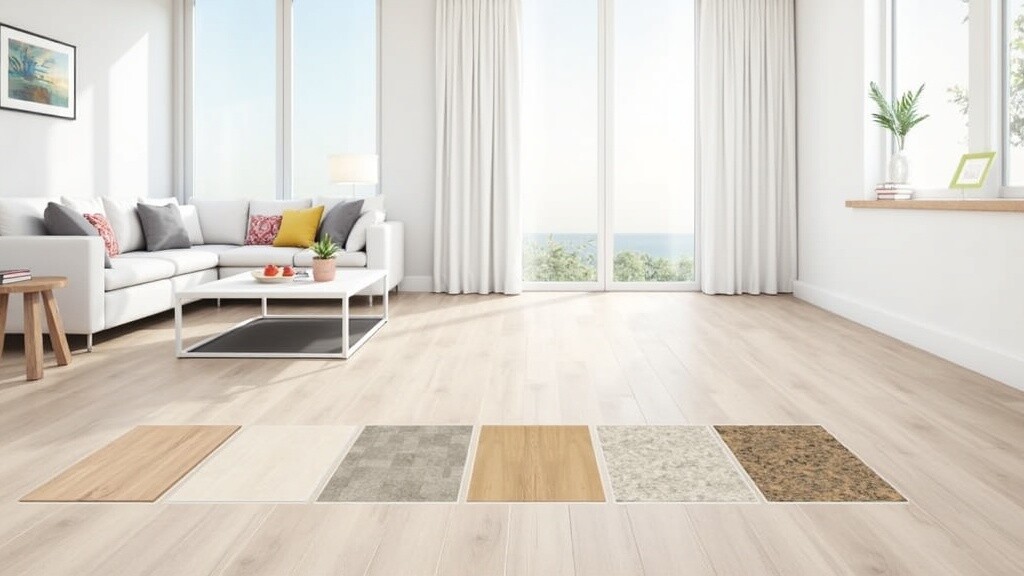
Affordable flooring options offer homeowners a chance to refresh the look and feel of their space without straining the budget. A simple flooring upgrade may change a room completely, making it brighter, cleaner, or more welcoming. Picking the right flooring comes down to your practical needs, style choices, and price range. In this article, I’ll share my experience and research to help you figure out which affordable flooring options could be just right for your home.What Makes a Flooring Option Budget-Friendly?
Affordable flooring costs less in both supplies and installation compared to high-end products like hardwood or natural stone. These materials are available at most home improvement stores, and lots of options are specifically made for easy DIY installation—which can trim costs even further. When I remodeled my own living space, I realized that each type strikes its own balance between toughness, style, and how much you pay in the end. It’s key to keep both upfront cost and long-term value in mind before making a choice.
The market for flooring materials has grown fast, thanks to new technology and a strong demand for practical home improvements. According to industry trends, vinyl, laminate, and engineered wood are still among the most popular options. They give you the look of pricier materials without a hefty price tag. This change makes it much easier to create the look you want on a budget.
Popular Affordable Flooring Choices
When searching for new floors, I focused on four budget friendly picks that balance quality with value: laminate, luxury vinyl plank (LVP), sheet vinyl, and engineered wood. Each has its standout features and fits different rooms or lifestyles. Here’s what I found out about each:
- Laminate Flooring: Laminate uses a fiberboard core with a printed surface layer. It does a great job of mimicking hardwood, making it a staple for living rooms and bedrooms. Laminate is tough against scratches and dents, so it handled high foot traffic in my place with no problem.
- Luxury Vinyl Plank (LVP): LVP is constructed from multiple layers of sturdy PVC vinyl and comes in planks, often with a wood or stone look. Waterproof by design, it shines in kitchens and basements. It easily shrugs off spills and pet accidents.
- Sheet Vinyl: This comes in rolls and covers floors with few seams. It’s typically the most affordable choice and is a favorite for laundry rooms, bathrooms, or basements. Sheet vinyl is quick to install, and for those with a very tight budget, it’s difficult to beat.
- Engineered Wood: Engineered wood features a thin layer of true hardwood bonded to a plywood or composite base. It’s a little pricier than laminate and vinyl, but noticeably more affordable than solid wood floors. Installation is also easier, making engineered wood a smart alternative to hardwood in many homes.
Trying out these samples at home, I found each material brought something different in terms of look and practicality, depending on each room’s personality. Sometimes I even used different types throughout the house so I could save money where it didn’t matter as much.
Understanding Installation and Maintenance
Installation costs play a big part in how affordable a flooring option really is. Many picks on my list can be installed by most homeowners, which skips professional labor charges. Laminate and LVP usually have a clicklock or adhesive system, and with basic instructions, I found I could manage either one. Sheet vinyl often uses a loose lay or peel and stick design, which makes it even faster to put down.
Keeping floors looking sharp doesn’t have to be hard. Laminate and vinyl just need sweeping and a damp mop now and then. Engineered wood does best when you avoid excess water and choose woodfriendly cleaners. I’ve learned it’s smart to factor in both how tricky the installation might be and what it’ll take for everyday upkeep to really judge the cost.
Room-by-Room Guide To Affordable Flooring
Certain flooring materials fit best in specific rooms. Based on my projects and tips from flooring experts, here’s what I’ve picked up:
- Living Rooms and Bedrooms: Laminate and engineered wood work well in these low-humidity spaces. Carpet tiles are another good option if you want softness underfoot and the ability to replace sections easily as needed.
- Kitchens and Bathrooms: For wetter environments, LVP and sheet vinyl both make sense. I put LVP in my kitchen so I didn’t have to stress about spills or water exposure. When the seams are snug, there’s little risk of moisture sneaking under the floor.
- Basements and Laundry Rooms: For belowground space, it’s worth picking floors that shrug off moisture and mildew. Both LVP and sheet vinyl stay solid even in humid or floodprone areas, which gives peace of mind in the event of unexpected leaks.
Matching what you need from flooring with each room’s use can help steer clear of mishaps or the need to redo floors sooner than planned.
Factors to Weigh Before Picking Budget Flooring
Choosing affordable flooring is about juggling durability, looks, installation friendliness, and how buyers in your market might view your home. Some key points I always weigh include:
- Durability and Lifespan: Certain materials like thick LVP or higherend laminated floors can go strong for 15 to 20 years with some routine care. Cheaper sheet vinyl may wear out faster, especially in heavy traffic zones.
- Style and Design: Looking at samples in your lighting at home makes a big difference. I set out samples and leave them there for days to see how they stack up throughout the day.
- Allergies and Pets: Those with allergies usually benefit from hard surfaces that don’t hang onto dust. For pet owners, it helps to pick scratch resistant and waterproof options.
- Resale Impact: Updating floors boosts comfort and style for you and can be a plus with buyers. In highend neighborhoods, some buyers expect real wood, but most are just looking for clean and modern spaces when house hunting.
I’ve come to believe that careful research helps people avoid regret and wind up with a floor they really appreciate.
Troubleshooting Challenges with Budget Flooring
Budget floors aren’t perfect and they definitely come with some challenges. I’ve come across a few issues you should know about:
- Bubbling or Warping: Water is tough on laminate and inexpensive vinyl. Quick cleanup is a must, and I always make sure the subfloor is totally dry before starting installation.
- Scratches and Dents: Heavy furniture or heels can leave marks; felt pads under furniture feet and avoiding rough movement keep things looking good longer.
- Fading: Lowcost sheet vinyl sometimes fades in bright sun. I combat this with nice area rugs and window coverings in spaces where sunlight pours in.
- Noise: Floating floors can sometimes sound hollow. Using a solid underlayment before installing laminate or LVP helps floor surfaces feel and sound more substantial.
With a little care and attention, these issues can often be minimized or solved quickly.
Extra Tips for Making the Most of Affordable Flooring
You can get a lot more life and style out of budget floors by trying a few tricks I’ve picked up:
Use Area Rugs: Rugs warm up hard surfaces and protect busy zones. They’re an easy way to shift the vibe of a room without spending big.
Lay Planks Thoughtfully: Positioning planks or tiles along the natural light or length of a room can make spaces feel longer and airier. I always plan the layout before starting an installation project.
Mix Flooring Types: Sometimes, blending LVP in kitchens with laminate or carpet in other rooms can save cash and create obvious visual zones. Transition strips create smooth, stylish shifts between materials.
Keep Up on Cleaning: Regular sweeping or vacuuming and using the right cleaner keeps even budget flooring fresh. Habits like these have helped my floors last longer and look better year after year.
Simple routines and a little bit of creativity help extend value without extra expense.
Frequently Asked Questions
How long does affordable flooring usually last?
Answer: With solid upkeep, you can expect laminate and LVP floors to stick around for 15 to 20 years; sheet vinyl usually lasts up to 10 years in areas with lots of foot traffic.
Can I install budget flooring myself?
Answer: Most affordable floors like laminate, LVP, and peel and stick vinyl are designed for DIY convenience. A few online tutorials and reading product guides got me comfortable enough to lay new floors by myself in several rooms.
What’s the top pick for homes with pets?
Answer: Waterproof LVP is a clear winner for pet owners. It shrugs off scratches, accidents, and is a breeze to clean. Laminate fares okay as well, as long as standing water isn’t a concern.
Wrapping Up Affordable Flooring Options
Choosing affordable flooring is about more than keeping costs down. The real goal is to find options that are practical, stylish, and comfortable enough for daily life. Looking back at my own updates, the best results came from balancing what looks good with what works—while sticking to my budget.
Testing samples, planning for easy maintenance, and staying focused on what each room really needs all helped me make smart choices. New floors can transform a home and make it feel brand new, without overstretching your savings. Affordable updates are within reach and can have a transformative effect on your living space.
